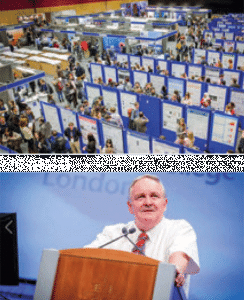
With more than 250 international speakers including two Nobel laureates the festival of neuroscience promised a lot. I am delighted to report that it did not disappoint. As a clinician I was hoping not only to learn about the current trends in neuroscience research but also to be able to construct a mental picture of what neuroscience is and how its main domains interact with each other and eventually translated to techniques and agents I can use in my every day practice.
It was clear that understanding how the brain works is mainly dependent on two techniques. In the cellular level; neurophysiological examination of a single neurone activity using a micro-electrode had been developed more than 50 years ago. The Nobel laureate John O’Keefe took us through this fascinating journey in his plenary lecture. I felt that his prize was not only recognition for his discovery of the hippocampal cognitive map but also recognition of the role neurophysiology played in the recent advances in neuroscience. Two recent developments revolutionised this field. The first is the extraordinary ability to insert tens of thousands of micro electrodes into a corresponding number of neurones enabling researchers to gather data about the neuronal activities of whole networks instead of a single neurone. Computational neuroscience then developed to help analyse these data, providing deeper insight into how such small networks function. We learned about mirror neurones firing when we perform tasks or observe someone else doing it (as presented by Giacomo Rizzolatti in the plenary lecture) and about the grid neurones mapping the enviroment in our hippocampus.
The second innovation is our ability to apply the same technique to humans. The ethical issues were resolved by recruiting patients with refractory epilepsy needing neurophysiological studies (surgical insertion of micro electrodes in their hippocampus) to determine which area needs ablating. The patient would then be asked to have cognitive tests and the data could be collected. This technique gives us a fascinating glimpse of how we store pictures of families or celebrities.
Examination of the macrostructures of the brain is still dependent on imaging especially functional MRI (fMRI). In my opinion, Diffusion Tensor Imaging (DTI) with its impressive ability to analyse white matter will be the quickest to translate into standard clinical practice. It demonstrated very good sensitivity in MND patients (Peter Bede, Trinity College Dublin) and for traumatic axonal damage (Adrian Own, plenary lecture).
There were two dedicated symposia discussing sleep. The main work focused on the role sleep plays in memory consolidation. This may be another area with potential to impact clinical practice especially in areas such as Post Traumatic Stress Disorder and dementia.
Stem cell research for neurological disorders was highlighted well during the meeting. Pluripotent stem cells or iPS cells are stem cells that can be produced directly from adult cells. Clive Svendsen’s (Cedars Sinai, L.A) lecture explored the therapeutic potential of these cells. Dr Svendsen challenged common opinion by suggesting we should focus on glial cells rather than neurones: the brain is composed of 10% neurones and 90% glial cells. He suggests that manipulating glial cells appropriately could help processes such as myelination or slowing down degeneration.
‘Do drug addicts have free well?’ This was an alluring and equally enthralling talk. It was fascinating not in the way I expected but in the way the excellent panel interacted. The speakers were neuroscientists, psychiatrists and an ethicist. This particular session highlighted the only weakness in pure neuroscience and what it can learn from clinical practice. Having a cocaine-taking rat as a model of a human drug addict seemed rather tagential from a clinician’s perspective.Similarly, the notion that radiological findings in the prefrontal cortex can tell us anything about free will is a difficult concept to accept. Nevertheless, everybody benefited from the discussion between the different disciplines especially the warning about neuro-reductionism: we need more humility when dealing with human nature as its representation by radiological findings, biochemical changes or neuronal activities is only part of the whole story.
Professor Nutts was part of this panel. On the previous night he gave an excellent lecture presenting overwhelming and convincing evidence against the current drug laws. I felt that Professor Nutts was asking too much of human nature. Like using rats to understand complex human behaviour, using evidence from the literature to inform public discourse about such as sensitive and complex area is extremely difficult in a liberal democracy. Failing to appreciate how irrational humans are is what gave us the credit crunch, PPI and Libor.
Even the most committed delegate will fail to manage navigating such a wonderful event. I did my best and had a great time in Edinburgh the heart and soul of the Scottish enlightenment. The old city dotted with the statues of Smith, Hume and other giants of the enlightenment was a perfect back drop for the festival.
ACNR 2015;15(2):29. Online 26/06/15